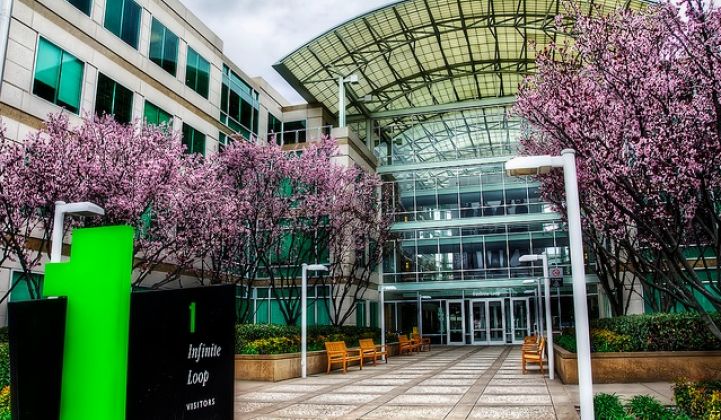You don't see Apple Inc. employees speaking at very many events, other than their own product launches.
So hearing from Apple's Energy Manager at Friday's SVLG Sustainability Summit was an event conspicuous by its lonesomeness.
Forget about sharing the presentation with you -- it's secret. I asked them to share it. In fact, Apple's energy speaker expressed some concern that the press was attending at all.
But effective efficiency principles at the corporate level are no secret.
And what works for Apple works most everywhere: employ best practices, displace fossil fuels, create new sources of energy, and stress accountability. "Quantify and back it up and stand by it," said Arik Cohen, principal at kW Engineering, who is also involved in Apple's efficiency efforts.
Mike Petouhoff, Global Energy Manager at Apple, spoke a bit about the company's energy usage and efficiency measures at Apple headquarters in Cupertino, California, as well as at Apple's data center in Maiden, NC, which is powered by fuel cells (10 megawatts) and solar panels (20 megawatts). He spoke of comprehensive energy retrofits as part of Apple's building portfolio strategy and the interaction between energy efficiency and renewable energy sources.
Petouhoff said that the goal at Apple was zero net energy, with its own sort of loading order:
- Efficiency
- Apple-owned on-site renewable generation
- Grid-purchased renewable energy
Cohen noted that although the number of employees at Apple headquarters has gone up, energy consumption has gone down. The energy efficiency case study at Apple's Infinite Loop did not involve sleek aluminum housings with a minimum number of buttons, but rather replacing chillers and consolidating chiller loops.
And it usually does come down to motors, pumps, chillers, dampers, rogue zones, and continuous commissioning. Nothing secret, and only sexy if you are an energy efficiency geek (like us).
When addressing the company's chillers at Infinite Loop, kW Engineering detected that the original vendor had overstated savings by 300 percent with an assumed -- and incorrect -- load profile.
Taking matters into their own hands, the Apple Energy Team devised a new configuration and control strategy for the building's chillers and cooling systems. The number of chillers was reduced from twelve to six, and the chiller paths were consolidated so that one loop served three buildings.
The total cost savings for the chiller project was $300,000 per year and resulted in a 10-year payback on a chiller with a 23-year lifetime. The project also involved installing VFDs (variable frequency drives) on "both evaporator and condenser pumps and new control sequences enabled variable flow on both sides of the chiller."
Cohen noted that "Apple also implemented a number of control projects including advanced sequences to reset supply air and duct static pressure at the air handlers. Together, capital and control projects implemented over the past four years have yielded a 30 percent reduction in energy consumption, while head count has gone up."
Petouhoff stressed that a "tenant improvement tracker" is of crucial importance if participating in a utility program.
The energy group at Apple wants the "strongest result at least cost," said Petouhoff. "The most important thing is to work with utilities to get a structured tool for funding and implementation."
Apple's solar array at its Maiden, NC data center.



